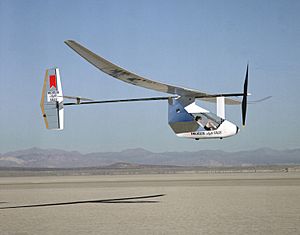Human powered aircraft facts for kids
A human-powered aircraft is a special kind of aircraft that flies using only the power of a human pilot or pilots. Imagine riding a bicycle in the sky! These amazing machines are built for fun, for challenges, and sometimes to win big prizes.
It's really hard to design a successful human-powered aircraft. The biggest challenge is making it super light but also strong enough to fly. It needs a very high power-to-weight ratio, meaning the pilot can produce enough power to lift the aircraft, even though the pilot isn't super strong. Because of this, many of these aircraft are made from very light and strong materials, like advanced composites. These are materials made by combining different things to get the best properties.
Even today, new human-powered aircraft are being designed and built. For example, Virginia Tech University is working on one called the "Iron Butterfly." Another cool project is the "Zephyrus" being built by Pennsylvania State University.
Contents
What is a Human-Powered Aircraft?
A human-powered aircraft is exactly what it sounds like: an airplane that flies only with the strength of a person. Instead of a noisy engine, these aircraft use pedals, just like a bicycle, to turn a propeller. The pilot pedals very hard to make the plane move forward and lift off the ground.
How They Work
These aircraft are designed to be incredibly light and have very large wings. The large wings help the plane get a lot of lift from the air, even at slow speeds. The pilot sits inside a small cockpit and pedals a system that spins a propeller. This propeller pushes the air backward, moving the plane forward. It's a bit like swimming, where you push water backward to move yourself forward.
The Challenge of Flying with Human Power
Flying a human-powered aircraft is one of the toughest challenges in aviation. It's not just about pedaling hard; it's about making the aircraft super efficient.
Lightweight Design
To fly with human power, the aircraft must be extremely light. Engineers use special, lightweight materials like carbon fiber, which is stronger than steel but much lighter. Every part of the aircraft, from the frame to the wings and even the tiny wires, is chosen to be as light as possible. This is why they often look very delicate.
Aerodynamics and Efficiency
The shape of a human-powered aircraft is very important. It needs to be very aerodynamic, meaning it can move through the air with very little resistance or drag. The wings are often very long and thin to create a lot of lift. The propeller is also designed to be very efficient, turning as much of the pilot's pedaling power into forward motion as possible.
Famous Human-Powered Flights
Over the years, many people have tried to build and fly human-powered aircraft. Some have achieved amazing things, showing what's possible with human strength and clever engineering.
Early Attempts
People have dreamed of flying with their own power for a long time. Early attempts often involved flapping wings, like a bird, but these were not successful. It wasn't until the 20th century, with better understanding of aerodynamics and new materials, that true human-powered flight became possible.
Historic Achievements
One of the most famous human-powered aircraft was the Gossamer Condor. In 1977, it won the Kremer Prize by completing a figure-eight course. This was a huge step because it showed that controlled, sustained human-powered flight was truly possible. Later, the Gossamer Albatross flew across the English Channel in 1979, a journey of 22 miles (35 kilometers)! This was an incredible feat of endurance for the pilot.
Another famous aircraft is the Daedalus, which flew 71 miles (115 kilometers) from Crete to Santorini in 1988. This flight set a world record for distance that still stands today. These flights proved that humans could indeed fly without engines, using only their own strength.
Building the Future of Human-Powered Flight
Even though many records have been set, engineers and students continue to work on human-powered aircraft. They are always looking for ways to make them lighter, stronger, and more efficient.
Current Projects
Today, universities and private groups are still designing and building these unique aircraft. They often compete in challenges to push the boundaries of what's possible. These projects help students learn about engineering, aerodynamics, and lightweight construction. They also inspire new ideas for future aircraft, even those with engines.
Why They Matter
Human-powered aircraft might not be used for everyday travel, but they are very important for research. They help us understand how to build super-efficient aircraft that use very little energy. This knowledge can be used to make all kinds of planes more fuel-efficient and environmentally friendly in the future. They also show the amazing things humans can achieve when they combine physical effort with clever design.
Images for kids
-
Zaschka's Human-Power Aircraft, Berlin 1934
-
Human-powered aircraft display at the US National Air and Space Museum
See also
 In Spanish: Vehículo aéreo de propulsión humana para niños
In Spanish: Vehículo aéreo de propulsión humana para niños





